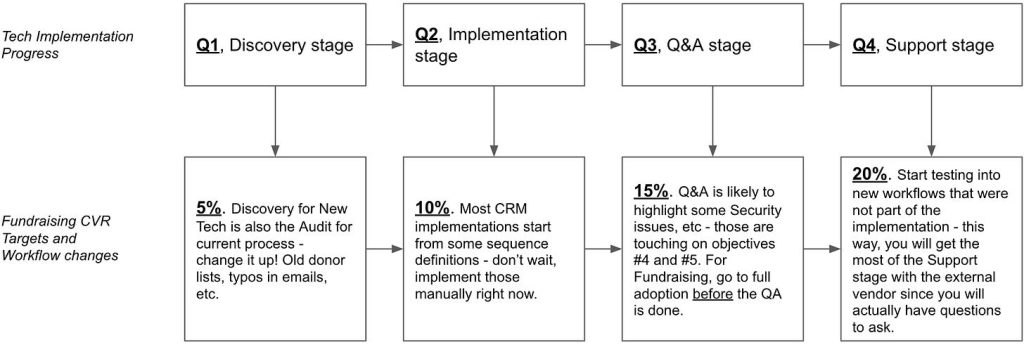
MarTech Implementation: Making New Tech ROI-Positive
I’ve seen and consulted on numerous MarTech implementations, ranging from more standard and widely-used CRMs and DMPs to DAMs (Digital Asset Management) platforms, several CDPs, and niche tools such as Social Listening platforms or an enterprise-grade visualization tool.
More than half of the ones I’ve seen went wrong. They created significant extra workload for the organization and increased costs. They also produced little incremental revenue – if at all – since tracking was usually impossible.
While grouping the root causes, I’ve since landed on 3 themes:
- Bad planning upfront. There are no clear objectives or definitions of success, no adoption (which is even more important than implementation), and no obvious way to cut losses early if plans go awry.
- Letting the IT/Technology org figure it out. The CIO/CTO figurehead and their team are valuable stakeholders – but they should never be the only ones.
- Falling for features, not for value. That’s how most of these tech tools are sold to us – shiny buttons and use cases but little details on how to actually recognize their value.
With some battle scars under my belt, I’ve developed a framework to help marketing teams make successful MarTech additions. I thought it might be helpful if I shared it here. Each of the three topics deserves a post dedicated to opening them up even half-decently, so I’ll focus only on the first one and tackle others in another edition of SPN. I’ll also break it down further into Bad Objectives and Bad Resources planning.
1. Bad Objectives.
Obvious, but let me say it – objectives should be tied to… Donor Lifecycle.
No new MarTech tool should be implemented because of the discount offered or because your friend at a different organization already uses it. Most of the tech tools get you into multi-year subscriptions and 6-to-7-figure implementation costs that you can’t get out of once you sign the contract, so if there’s no clear need – don’t do it. Not even for the shiny case-study with the vendors brand logo slapped next to yours. It’s not worth it.
Objectives – ie, Value – can be of two types:

The cost in the diagram can mean either the marketing budget or the labor cost of your team executing a certain task/program. Unless you’re part of a large organization with 50+ people in Marketing/Fundraising, tech is unlikely to considerably cut your costs through automation (AI, we have high hopes for you).
In most cases, it’s either about cutting marketing spending while maintaining the same result or growing the revenue generated by the same level of spend. Both of those are increasing ROAS use cases. And tying this to the Donor Lifecycle – they become Conversion Rate use cases since tech is unlikely to help you increase AOV, and those 2 constitute the ROAS.
So, my #1 rule is to identify the step of the Lifecycle where the CVR is currently the lowest and look for MarTech solutions that can help me address it. If your current CVR takes a hit for people converting from Cash Donors to Monthly, DMP is unlikely to help – while a CRM with strong marketing automation functionality can.
I usually set the target at 20% CVR improvement, maintaining the current volume of donors. So, if I currently have 100,000 new Cash donors monthly, converting to Monthly at 5% CVR with an average LTV of $150, that 20% improvement can help me generate 1,000 more Monthly donors per month. That’s $150,000, or $1,800,000 annually.
The $1,800,000 revenue gain is now my Objective.
2. Bad Resources.
By resources, I mean all the Costs available to me. If my objective is to generate $1.8M in incremental revenue over a year (or $5.4M over 3 years – a “standard” length of any MarTech subscription), I want to do so with at least 2:1 ROI (per my CFO). That means my cost over 3 years cannot exceed $2.7M. That is the all-in cost – including the actual Tech cost, third-party implementation support, and labor cost of the team adopting the platform internally.
In my experience, the cost of any tool over 3 years looks like a 50%:35%:25% breakdown of the total – front-loaded to account for third-party implementation in the first year (20%) and ongoing support in the second year (15%).
25% in the third year represents a baseline – with 15% being the license cost and 10% for the internal team’s adoption that’s present every year thereafter.
50% for the first year is really 15% for the license, 10% for the internal team, and 25% for the third-party implementer.
Applying it to our $2.7M 3-year cost limit, the total available to me for a first-year license and implementation services is only $1.08M.
In a scenario of aiming to increase the Cash to Monthly CVR, that “cost limit” is unlikely to get me a Ferrari – e.g. an SFMC-setup – so I’d need to consider other options, such as opting in for a partial tech scope or another tool altogether, for example, HubSpot.
Having the cost limit also helps in negotiations with vendors. Communicating your budget limit to them in advance cuts the crap of unnecessary feature-selling and gets straight to the point – which is exactly what you need. At this point, I would shop around and look for a tech vendor and a suggested implementation partner that can convince me the most of their ability to deliver.
It gets overly subjective, but I tend to lay my cards out on the table and tell “candidates” exactly what I need (20% CVR increase from Cash donors to Monthly for a maximum 1-year cost of $1.08M) – and then look for ways they propose to get there and the Value they’re expecting from it. The best MarTech sales pitch I ever got was from Adobe Analytics several years ago – they were the only ones who almost didn’t talk about their features, only stone-cold numbers.
We didn’t buy the tool in the end, but I’ll credit them for trying!
Check out the recap of Objectives and Resources below:

Bonus: Who’s Doing the Doing?
Let’s say that last week you picked HubSpot as your tool of choice and BestHubSpotCo as the implementation partner. Now you just throw it over the fence to your CTO/CIO – and your job’s done!
Not so fast. Your Tech counterpart flooded you with use cases, wrote a 100-page long data security addendum, and told you the only way you can use this tech is if you learn how to integrate the Kanban dashboard into Agile planning sessions.
I don’t want to be diminishing here – the CTO, and especially CIO, is usually my best ally in the C-Suite. They understand the Donor data as well – if not better – than I do. But they have different objectives. Their KPIs are usually data cleanliness, security against risks, and minimizing disruptions to the core services – those are the website and donation platform. Nowhere in their annual review will they be assessed against an increase in revenue from the core donor base.
Building a cross-functional team accountable for implementation – internally and externally – is unavoidable. Here are the objectives again I listed above for a successful MarTech launch:
- $1.08M budget for the first-year license and external implementation services.
- $220k budget for the first-year internal team cost.
- $1.8M in the first-year revenue gain – coming from Cash to Monthly conversion rate increase of 20%.
- [new] Data security – meeting the regulatory standards and not getting us into trouble.
- [new] Stability – maintaining the speed of other platforms and parts of the tech stack without interruptions.
The latter 2 the tech team will need to take care of – but they are important to remember. I would assemble the following team to achieve these:

Note the main “lead” on the project – that should be the person in charge of Fundraising, NOT Technology. The end user should have the final say and bear the ultimate responsibility.
Another important part is who manages the external partner. Tech teams have the best PMs usually – tap into that!
Mapping the 5 objectives above to key people on the project, I suggest the following:
- $1.08M budget for the first-year license and external implementation services – Project Manager Lead
- $220k budget for the first-year internal team cost – Project Manager Lead
- $1.8M in the first-year revenue gain – coming from Cash to Monthly conversion rate increase of 20% – Audience, Email, and Reporting Leads
- [new] Data security – meeting the regulatory standards and not getting us into trouble – Technology Person-In-Charge
- [new] Stability – maintaining the speed of other platforms and parts of the tech stack without interruptions – Technology Person-in-Charge
Given a tight internal budget of $220k, an internal project manager must be harsh on everybody. You won’t have more than 25% of anybody’s capacity to stay within those figures. So set those targets – and move on. Proper team assembly will already take care of 4 out of 5 objectives above, don’t spend too much time on it. An objective requiring most of your ongoing attention is #3 above – let’s dig into it.
$1.8M in the first-year revenue gain – coming from Cash to Monthly conversion rate increase of 20%. The main blocker for this objective will be timelines. I touched on Bad Processes planning last time, but it should be reworded as Bad Sequencing.
CRM implementations will include multiple workstreams such as Discovery, Implementation, QA, Training, and others – all taking up multiple weeks, being delayed because of PTOs and sick leaves, and many other unforeseen circumstances. Let it run its course – and you will find yourself at a 12-month mark with no understanding of incremental revenue and, likely, no incremental revenue at all. That is why I visually separated the fundraising team on the diagram above – they should operate on their own timeline, making sure that revenue-generating objectives are not left to be done after the implementation – they need to be done concurrently with it.
In conversations with peers while I was writing this, some people said I should have factored in gradual revenue growth YoY – e.g., $1M in Y1, $1.8M in Y2, and $2.6M in Y3 to get to the 3-year total of $5.4M. I usually don’t do that – front-loading the cost but back-loading the projected results leaves you at the mercy of assumptions.
Our goal for this whole project is to grow the CVR by 20%, but it’s not all-or-nothing. One of the most frequent mistakes I see fundraising teams make is to treat “implementation” as a 0/1 state – the new tool is either “implemented” or “not implemented.” All the beautiful use cases planned out for the end state – automated emails, personalized content, sequenced messaging for different donor personas – are all right. The thing is, they can be done manually.
In the CRM automation scenario, I would keep my fundraising team accountable to reach the 20% CVR growth target already in Y1, regardless of the complete implementation. Only then will I be certain the new tool will succeed long-term. Note the below schematic example of how to use the tech implementation progress to recognize partial gains:
